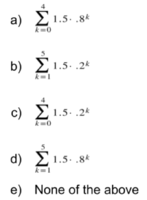So this isn't Calculus specifically just basic summation notation, so forgive me if this is the wrong subsection. Here's the problem:
A ball starts at an initial height of 1.5 meters above the ground. Each time the ball bounces, it reaches 80% of its previous height. Which of the following accurately reflects the total distance the ball has bounced after 5 bounces? Please only consider the distance that the ball is traveling downward.
I attached the answer choices.
I eliminated B and C off the bat, since multiplying by .2 is not correct. However, I feel that the answer is E, none of the above, because the summation must start at 1.5, which A gives, but it must bounce 5 times, not 4 as in choice A. Am I looking at this problem the wrong way?
A ball starts at an initial height of 1.5 meters above the ground. Each time the ball bounces, it reaches 80% of its previous height. Which of the following accurately reflects the total distance the ball has bounced after 5 bounces? Please only consider the distance that the ball is traveling downward.
I attached the answer choices.
I eliminated B and C off the bat, since multiplying by .2 is not correct. However, I feel that the answer is E, none of the above, because the summation must start at 1.5, which A gives, but it must bounce 5 times, not 4 as in choice A. Am I looking at this problem the wrong way?

